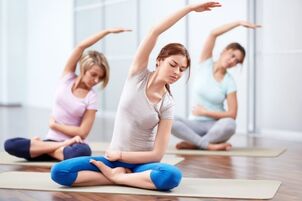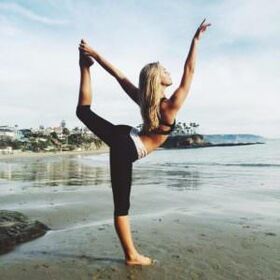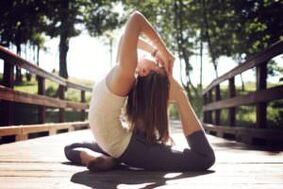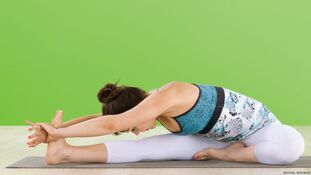In finding something new, not only diet is used, but also philosophical teachings. For example, with the help of regular yoga exercises, you can achieve harmony with the external environment, close environment and your own body. The new direction in the fight against obesity opens up the secret knowledge of the inner world and the control of important processes responsible for metabolic processes.

Principles of yoga in combating overweight
The most valuable thing that can be achieved by practicing yoga is well-being and a healthy psycho-emotional background. This is the best that a person can give to himself, because a healthy mind is born in a healthy body. There is now a lot of talk about the effectiveness of yoga in combating weight loss.
Experts note the following changes that have a beneficial effect on weight loss:
- hormone normalization;
- regulation of the endocrine system;
- appetite suppression;
- acceleration of metabolic processes;
- improves blood circulation.
In addition, periodic sessions have a positive effect on the general situation:
- prevention of cardiovascular disease;
- expands flexibility;
- strengthening of muscle tissue;
- relieves pressure on joints;
- strengthens the spine.
But keep in mind that not all areas of yoga contribute to weight loss.
Easier to use:
- pranayama (daily respiratory complex);
- hada (every morning on an empty stomach);
- Ashtanga Vinyasa (combined with cardio).
To effectively fight obesity, it is recommended to revise the principles of diet, by prioritizing seafood, lean meats and fresh fruits / vegetables. Fatty, fried and smoked foods will inhibit the weight loss process and the results can be obtained in pounds.
What type of yoga is best for you
If you decide to use one or more yoga techniques for weight loss, you should contact a trainer for advice and suggestions. In addition, you can watch video tutorials that in-depth introduce the techniques of doing exercises.

You can choose one type of yoga for weight loss:
- Ashtanga Vinyasais energetic, requires little physical fitness. Exercise uses the energy key to help redistribute energy throughout the body. Periodic practice has a positive effect on mental health and clarity.
- Hatharepresents a classic trend in yoga. The main principles are awareness and relaxation. While doing each exercise, you must turn on awareness and feel every element. The important task of this technique is considered to be victory over your body without any force. Relaxing muscles allows you to perform fluoride movements without feeling pain. But they do it gradually, through regular training.
- Kundaliniinvolves doing physical exercises in combination with proper breathing. In the process of action, a person is immersed in meditation. The duration of meditation can vary from 3 minutes to 2. 5 hours. If you master this technique, one will understand the feeling of happiness and contentment, which in no way encourages thinking about food.
- Vishrantainvolves working more with the mind than with the body. In the process of training, calmness, serenity, physical relaxation are achieved. This technique relieves stress, depression and obsessive thoughts.
- Nidrais a bit like visranta. To do this, you need to rest completely with stretching the muscles. The body does not move for long. During exercise, brain activity functions. This technique eliminates fear, psycho-emotional blocks. During the session, thoughts are focused on a particular picture.
What you need for class
Before starting to master this technique, it is recommended to see a doctor to exclude contraindications. Tips and at least introductory lessons from the trainees will also be very helpful. Next, the room is chosen to hold a class. This can be the corner of the living room. The main thing is that the sound and strong household do not interfere during the session. In the warmer months, you can do outdoor exercises. Sun and grass are great additions to your activities.
A lot of exercise is done while lying down and sitting. For convenience, use a rug or mat. Clothes must be light and elastic, which allows for free stretching. You do not have to put anything on your feet. Yoga provides the unification of one's own and worldly energy.
While performing various elements, additional inventory may be required:
- support blocks that help beginners master difficult asana;
- straps for easier stretching.
Videos and tutorials are no less useful in home training. To immerse oneself in an atmosphere that conforms to the teachings of philosophy, mantras and aromatherapy are required.
Basic rules
To understand at least the basics, you need to master this technique and follow some strict rules:

- Before running a class, you need to do a wet cleaning in the room and vent it.
- Prepare a rug or mat to exercise on the floor.
- Do not eat before class, and also do not eat immediately after graduation.
- Sessions should be held daily for at least 15 minutes.
- Breathe through your nose just while exercising.
- The relaxation element is recommended for exercise after menstruation.
- Pregnant women are only allowed to include light exercise in the complex.
- Beginners should evaluate their fitness level and age. Negotiations with coaches will be appropriate. For the elderly, yoga and therapy areas are more appropriate. Ashtanga Vinyasa is recommended for energetic young women.
- When compiling a training program, you should provide a gradual increase in load: from simple to complex elements.
- If you feel severe or severe pain during exercise, postpone exercise. If necessary, see a doctor.
- To use yoga to lose weight, consistency is important, so do not postpone the session. Detention order can be based on mode of operation: daily, 3 times a week, daily, etc.
A set of exercises for weight loss
Tadasana
Body position, standing on the mat with your hands down and your feet together. Straight posture. You need to stand for a while. At this point, the abdomen is pulled upwards, which makes the abdominal muscles function. (All asana performed in a standing position starting from this position).

Vrikshasana
From a standing position, fold the arms over the chest as the Indians say, and bend one leg, placing your foot on the inside of the knee joint of the other leg. Raise your hands above your head and stand for a few seconds. Change body position by changing legs. When changing positions, the hands should be lowered to the chest.
Trikonasana
From a standing position, jump with your feet and arms to the side. The legs should be in a position wider than shoulder level. Rotate the right leg to the right, it should take an upright direction in relation to the left leg. Without bending the knee, bend to the right, trying to touch the right foot with the fingers of your right hand.
Correct if the palm rests on the floor. At the same time, lift your left hand upwards, turn your head, point your gaze to the fingers of your left hand. Shut up for a moment. Next, the body takes its original position and changes its position, but by turning to the left.
Patchimottanasana
Sit in a prone position on the mat. Stretch your arms forward, start tilting towards your legs. You need to grasp the foot with the finger, while not bending the knee. Lower your head, press your chin to the sternum. Fix the element for a moment and return to the lying position. Repeat the exercise several times until you have sufficient endurance. Do not withstand severe pain.
Sarvangasana
From the cartilage position, lift your legs and body to the "birch" position. Support your back with your hands, straighten your legs. Freeze the elements for 1 minute to begin.
Janu sirshasana
Starting position - sitting on a mat with legs and arms apart. Bend the right leg and place the foot on the outer thigh of the left leg (in the crotch area). Bend the body straight, holding the left leg with your right hand. Place your left hand behind your back. At the same time, try not to bend your left leg. Hold the position for a few seconds and return to the starting position. Repeat the same steps, but change sides.
Hold the position for a few seconds and return to the starting position. Repeat the same steps, but change sides.
All exercises are repeated 3-5 times at the initial stage. The holding time of the pose gradually increases. You do not have to endure the sharp pain. The body will become accustomed to stretching movements and the possibility of introducing more complex elements.
How many kg can you lose weight
In combination with proper nutrition, you are guaranteed to lose 4-8 kg in the first month. At the same time, you do not have to spend time with strenuous physical exercise and hunger.
The process of separating fat cells stored in different parts of the body, if all the rules are followed, will start from the third week.
In the first 14 days, the body eliminates excess fluid, which in weight values exceeds fat indicators. Therefore, in the first 2 weeks, you can lose weight up to 10 kg, and in the following weeks, the result will be minus 1-2 kg.
Advantages and Disadvantages
Benefits:
- internal world stabilization and internal organ work;
- gradual weight loss prevents weight gain;
- suitable for any age;
- exercises aimed at flexibility and strengthening of the chest corset;
- normalizes psycho-emotional mood;
- improves the function of internal organs and vital systems.
Disadvantages:
- results in gradual and not rapid weight loss;
- is hard to find motivation;
- it is impossible to achieve results without mastering the technique.
Contraindications:
- disorders of internal organs;
- hypertension;
- ARI, ARVI;
- infection;
- oncological diseases;
- Craniocerebral trauma.
Pregnant and lactating mothers should be delayed. It is also not recommended to do exercises during recovery after serious injury or surgery.
Comments
I have been doing Kundalini yoga for 5 months, and recently I started mastering hada. I enjoy doing muscle stretching exercises. After 2 weeks of training, the pain in the knee joint disappeared. I started wearing heels again, which for 8 years I could not wear for more than 10 minutes. During the lesson, I did not realize how my favorite item became 1, and then 2 sizes larger. My achievement in a short period of time was minus 12 kg. But what is even more shocking is the excellent state of health and the absence of headaches.
I have been practicing Hatha Yoga for the second year. I started learning after giving birth, which was very difficult and weakened my health. Now I feel great. Thanks to a set of exercises, the figure is in perfect condition. I recommend to everyone to try to adapt to their body and the people around them.
I am skeptical of my husband's advice to try yoga to lose weight. He has been doing this for 7 years, I prefer photography than actually earning an income. Dynamics, creativity and creativity have always been my companions. And then yoga - serenity, calm and healthy and all that. . . Nonsense, I think. Six months have passed and now I understand what I am missing. Harmony and caution settled in my heart. And thanks to hasa, the figure gradually began to acquire good shape. Of course, yoga is not a food, you can not lose a lot of weight at once in a month. But there is no return for my loss.















































































